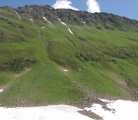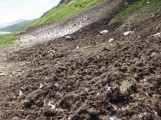 |
|
|
|
|
|
|
Snow |
|
Avalanches are of great importance in many alpine regions. Although most avalanches have little direct contact with the soil surface some have a great erosive effect, and pick up and transport vegetation as well as soil and boulders. The catchment of most avalanche paths is at or above tree-line. The avalanches often reach into the subalpine zone, leaving clearly visible tracks in the forest. |
1 - Avalanche tracks reaching into the subalpine zone (77K) |
|
What are the consequences of avalanches? |
|
Destruction of the vegetation along typical
avalanche tracks results in environmental (substrate, community) gradients perpendicular to the
track that range from the centre, where any vegetation and soil are frequently torn away, to less
disturbed vegetation away from the main track. Within the track, the only plants are those which
can withstand the effects of the falling snow pack or which grow relatively rapidly. Avalanche tracks are used as corridors by animals such as the chamois. The plants of avalanche tracks include some species that are rather rare elsewhere and which may provide habitat or important resources for animals. An example is the big huckleberry (Vaccinium membranaceum, Ericaceae) which provides a habitat for the grizzly (Ursus arctos) in Glacier National Park, Montana. |
2 - Avalanche tracks, Oberalppass, Switzerland
|
|
In the runout area at the base of an avalanche the
high amount of snow that is piled up may, in addition to the destructive forces,
affect the vegetation by shortening the growing season and causing soil compaction. |
3 - Avalanche runout area in June (122K) |
29 August 2011 |
||
| |
||


